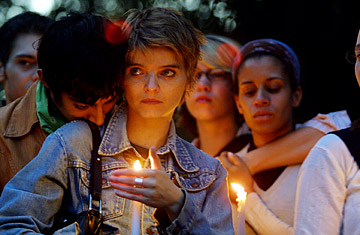
Jane Gaffney and Nyle Cavazos-Garcia take part in a candlelight vigil in Washington Square Park on September 12, 2001 in New York City.
9/11 was devastating in terms of lives lost — nearly 3,000 people were killed in the attacks — but it was not physically destructive (with the obvious exception of Ground Zero) on the same massive scale. Since most of New York City remained structurally intact, an intense focus was placed on the psychological needs of its residents (and, to a lesser extent, on residents of Washington, D.C.) One month after 9/11, the National Institute for Mental Health gathered together a group of international experts to figure out how to best help a traumatized population, but as a new report in American Psychologist explains, there was no clear model of what to expect and how to proceed.
"After reviewing the extant literature on postdisaster and posttraumatic interventions, panelists acknowledged that given inconsistencies and gaps in the literature base, a clearer framework for disaster behavioral response was needed," write Patricia J. Watson and Melissa J. Brymer, both of the National Center for Child Traumatic Stress at UCLA, and George Bonanno of Columbia University in a special issue titled "9/11: Ten Years Later."
At the time, the mental health community was flying blind, but the events unfolding before them have since taught us much about the long-term, psychological impact of mass violence. "In a way, 9/11 put trauma on the map and Americans psychologists started paying more attention to it and could actually study what was happening," says George Bonanno, one of the authors who contributed to the special issue. "Before that, we really didn't know how people would be affected on a population level."
The word "resilience" is now frequently invoked when describing 9/11 survivors. It's not just a catchphrase — the research bears out the fact that we seem to have certain innate coping skills to get us through disasters. Prospective and longitudinal studies of people who were impacted the most suggest that the proportion of survivors who developed chronic problems, such as PTSD or complicated grief, rarely exceeded 30 percent, and in some cases was considerably lower. Several surveys of rescue and recovery workers and other first responders estimated prevalence rates for PTSD between 6 and 12 percent; for World Trade Center evacuees it was 15 percent.
Moreover, there were certain social and psychological predictors beyond mere exposure to the attacks that influenced who would be most aversely affected, such as the absence of social and economic support or higher levels of contextual life stress. Even a lack of previous experience relevant to coping with disasters made a person vulnerable to long-term problems.
As to what made people more resilient, there were a number of factors, including personality traits, social support, and a sense of oneself as capable of coping with adversity. The research confirms that most disaster survivors do not need to see a mental health professional, and there is very little evidence for the usefulness of any kind of therapeutic intervention in the first month. The growing consensus is that in the immediate aftermath of a disaster, survivors need practical, logistical help to meet their basic needs, whether communicating with loved ones or transportation or money. The goal of this type of approach, known as Psychological First Aid, is to stabilize survivors and connect them with additional resources as a way to reduce stress and encourage adaptive functioning. The time for therapy is later on, and only after an accurate assessment. As psychiatrist and epidemiologist Simon Wessely has written, "Once the dust has settled, literally and figuratively, those with defined psychiatric disorders can access decent quality treatment."
In the end, the largest lesson for the mental health field is that when disaster strikes, practitioners should not get in the way of natural coping. Instead of trying to provide services to the entire population, they should, after a month or so, target the people who might need it most and then tailor their approaches, taking individual and cultural differences into account. As to which treatments work best for what, much more research needs to be done. In that sense, "9/11: Ten Years Later" tells us more about what not to do than what to do.
Ruth Davis Konigsberg is a senior editor at TIME.com and the author of The Truth About Grief: The Myth of Its Five Stages and the New Science of Loss, which was just published in paperback.
